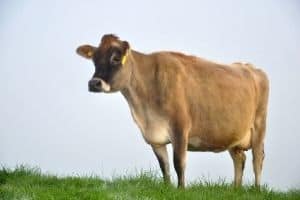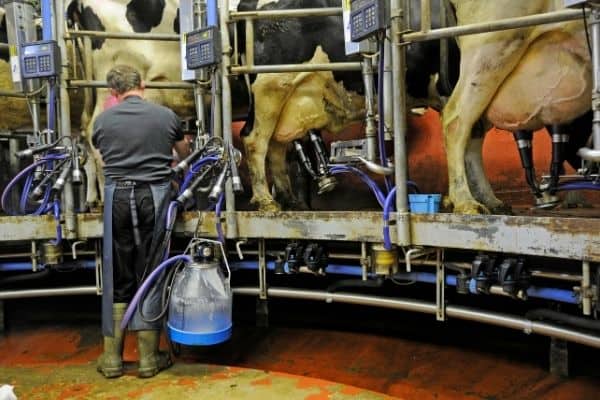There are many common misconceptions about cattle farming, let alone the individual sub-practices. Not too many people know the differences between Dairy Farming and Beef Farming. A few factors must be understood to clear up any confusion.
Dairy farmers breed and raise cows to produce milk. Dairy cows' diets are specialized to promote milk production, and they spend most of their time in barns. Beef farmers raise their cows to maximize muscle and fat growth. Beef cows have more generic diets and require more extensive pastures to graze.
There are many factors involved in cattle farming, such as cow breeds, raising techniques, and farmers' relationships with their cows. Did you know that many cows move to different farms throughout their lives? Everything you could need to know is covered below.
Breeds and Visual Distinctions
Some of the most critical distinctions in the different types of cattle farming are in the cows themselves. Some cows are better at producing milk, while some are bred to grow larger, stronger, and more quickly.
Dairy cows are always skinnier due to their fast metabolism . This helps them to convert nutrients into milk quickly. A healthy dairy cow will have a slightly visible rib cage and distinct protruding hip bones. Dairy cows have large udders that hang low to the ground, making milking more efficient. Even bulls appear more feminine as a result. Breeds include:

The Guernsey – Known for their vitamin-rich and off-color milk

The Jersey – These are smaller brown cows

The Holstein- This is the most well-known breed with its black and white color pattern
Check out this video about Guernsey cow's Milk. See how the milk has golden color due to the presence of high levels of beta carotene.
Beef cows have a much more comprehensive range of breeds and colors. A few common species are:

The red and white Hereford

The Simmental, which is one of the oldest breeds

The most common and well-known Black Angus
Nutrient and Feed Consideration: Dairy Vs. Beef Cows
Necessary Equipment: Dairy Farm Vs. Beef Farm
A beef farm will typically have a narrower range of equipment. Cattle can be kept in a roofed shed instead of a full barn. Feed bunks, water troughs, and platform scales are also needed.

Cattle Weighing Scale Platform
The most significant difference in a beef farm will be that it has much larger pastures for the cattle to graze in. A beef farm will usually have 1.5 to 2 acres per cow.
A dairy farm will have all the same equipment as a beef farm and more. A barn is needed instead of a shed as the cattle will spend much more time inside.
A milking parlor will either be inside the barn on in a connected building. The parlor will have all the specialized equipment for the actual milking process. There are many varieties of milk parlors. Some require the cows to be guided to the station on a farmer's schedule, while others, called voluntary parlors, allow them to choose when to be milked.

All parlors have computerized equipment for monitoring the amount of milk produced by each cow so that farmers can accurately assess their health and output. Depending on the farm, it may also have storage and refrigeration equipment to hold the milk for extended periods or even its own small processing plant to pasteurize the milk.
Dairy farms will have considerably less land used by open pastures as dairy cows spend less time grazing and require fewer nutrients from the ground.
Raising and Farming Beef Cows
In modern farming practices, beef cows are no longer spend their entire lifetimes on a single farm. Typically, a cow will be born on one farm: a cow-calf farm and raised there for about seven months, when they will weigh about 400-600 pounds, depending on the breed.
Afterward, beef cattle will be transferred to the secondary cattle farm, where they will be fed a specialized diet of hay and select grains. After six months at this secondary farm, the cow will weigh between 800-1200 pounds and be transferred again to the final farm, where they will be fed a diet of protein and vitamin-enriched grains for about another five months.
By the end of this process, they will weigh roughly 1500 pounds. At that point they are sent to the slaughterhouse.
Cow-calf farmers describe their relationship with their cows to be "pet-like," while the farmers in the latter parts of the process consider it more "factory-like," having no real relationship with the cattle.
A beef farmer will typically pair one bull with twenty-five cows for breeding. Bull calves that are selected for later breeding are castrated before being let into the pasture. Despite common myths, this does not impede the bull's growth.
Raising and Farming Dairy Cows
Dairy cows are still commonly raised their whole lives on a single farm, though some farms will get their calves from a cow-calf farmer that breeds dairy cows beside their beef cows.
Dairy cows are typically raised for a year before being bred. It is only after giving birth that a dairy cow will produce milk. She must be milked at least twice a day, either by the farmer or by her calves, to ensure she continues lactating. Dairy cows can produce between 5-10 gallons of milk per day. This total output depends on the breed and the amount of water the cows are given, and the specifics of their diet. Higher protein diets and around thirty gallons of water a day will maximize milk production.
Farmers will breed their cows again shortly after giving birth to ensure continued milk production once their calves have outgrown milk feeding. However, cows will need to stop being milked about three months before giving birth to prepare their bodies for the new calf.
Not all dairy farmers keep their own bulls. Some prefer to take their cows to other farms for breeding or even have a specialist perform artificial insemination.
Dairy farmers generally have much more personal relationships with their cows, giving them names, learning their preferred habits, and sometimes playing games with them. Still, on larger farms, it is common to sell cows that are under-producing milk to slaughterhouses. In some cases, a cow will birth more calves than she can care for while still producing milk for the farmers. The calves are often also sent to slaughterhouses to be made into veal, which dairy calves are better for than beef cows.
Summarizing Dairy and Beef Farming
There are many differences between all parts of dairy farming and beef farming. Dairy cows require more:
Farmers often say that dairy farming is more rewarding. An adequately raised dairy cow can benefit for years, while only the best beef bulls will live for more than eighteen months. In either case, correctly understanding the differences in breed, diets, and equipment is essential to practical farming.
